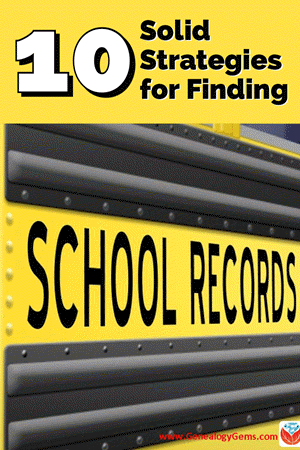Blog

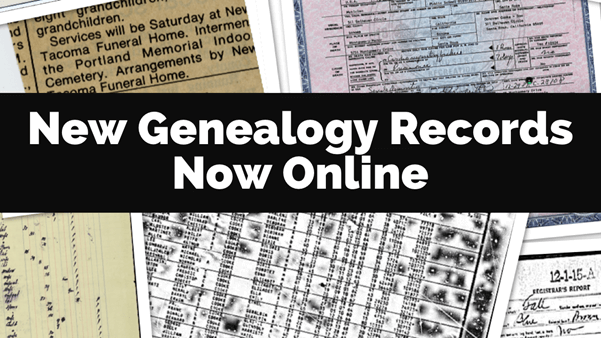
New Genealogy Records Available Online April 15 – May 15, 2020
With so many new records coming online, I’m going to focus today on collections that are new, or have had a substantial update. These records are from around the world, and offer excellent opportunities to expand your genealogical research.
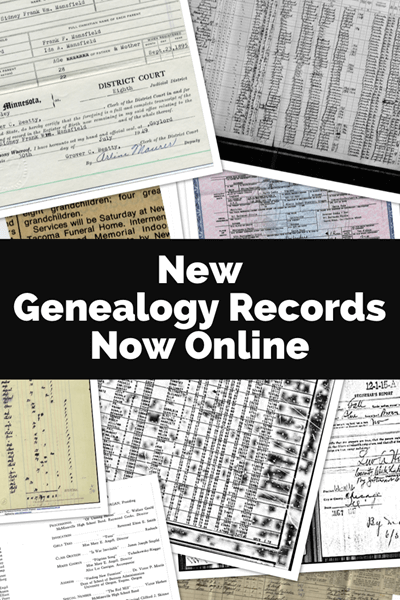
Keep reading here at Genealogy Gems for all the latest new records.
New Record Collections at FamilySearch
New indexed record collections offer new hope for genealogists yearning to bust a brick wall in their family tree. FamilySearch has recently launched several noteworthy new genealogical record collections. Some have substantial amounts of new records and some are just getting started. As always, they are free to access with an account. Here’s the latest:
England
England, Devon, Plymouth Prison Records, 1821-1919
Indexed Records: 13,495
Germany
Germany, Saxony, Church Book Indexes, 1500-1900
Indexed Records: 32,709
Ireland
Ireland, John Watson Stewart, The Gentlemen’s and Citizen’s Almanac, 1814
Indexed Records: 17,266
Norway
Norway, Oslo, Akershus Prison Records, 1844-1885
Indexed Records: 808
Peru
Peru, Piura, Civil Registration, 1874-1996
Indexed Records: 878
United States
California
California, Geographical and Name Index of Californians who served in WWI, 1914-1918
Indexed Records: 27,306
Hawaii
Hawaii, Hawaiian Islands Newspaper Obituaries, 1900-ca.2010
Indexed Records: 243
Maine
Maine, Alien Arrivals, 1906-1953
Indexed Records: 199,010
New Mexico
New Mexico Alien Arrivals, 1917-1954
Indexed Records: 17,240
Oregon
Oregon Death Index, 1971-2008
Indexed Records: 1,063,054
Oregon Divorce Index, 1991-2008
Indexed Records: 340,289
U.S. Newspapers
United States, GenealogyBank Historical Newspaper Obituaries, 1815-2011
Indexed Records: 1,827,447
Updated Records at FamilySearch
FamilySearch has also added indexed records to several interesting existing collections:
United States
United States, New York Land Records, 1630-1975
Indexed Records: 3,868,777
New York, Southern District, U.S District Court Naturalization Records, 1824-1946
Indexed Records: 103,000
Michigan, Detroit Manifests of Arrivals at the Port of Detroit, 1906-1954
Indexed Records: 323,121
Austria
Austria, Vienna, Jewish Registers of Births, Marriages, and Deaths, 1784-1911
Indexed Records: 27,317
Added indexed records to an existing collection comprising 1.8 million historical records.
Chile
Chile, Catholic Church Records, 1710-1928
Indexed Records: 8,575
Chile, Cemetery Records, 1821-2015
Indexed Records: 87,220
Italy
Italy, Benevento, Civil Registration (State Archive), 1810-1942
Indexed Records: 155,594
Italy, Brescia, Civil Registration (State Archive), 1797-1943
Indexed Records: 78,275
Italy, Salerno, Civil Registration (State Archive), 1806-1949
Indexed Records: 32,447
Images: 31,969
Peru
Peru, Diocese of Huacho, Catholic Church Records, 1560-1952
Indexed Records: 260,438
Venezuela
Venezuela, Archdiocese of Valencia, Catholic Church Records, 1760, 1905-2013
Indexed Records: 306,392
MyHeritage
MyHeritage, the leading global service for discovering your past and empowering your future, announced today the publication of three important Greek record collections:
- Greece, Electoral Rolls (1863–1924),
- Corfu Vital Records (1841–1932),
- and Sparta Marriages (1835–1935),
comprising 1.8 million historical records. Click here to start a 14-day free trial at MyHeritage.
This release constitutes the first substantial set of Greek record collections available on MyHeritage. All three collections have been indexed by MyHeritage and for the first time are now searchable in English, as well as in Greek. The total size of MyHeritage’s historical record database is now 12.2 billion records. This release positions MyHeritage as an invaluable genealogy resource for family history enthusiasts who have Greek roots.
“As the cradle of western civilization and a crossroads of continents and cultures, Greece is becoming a gem among MyHeritage’s historical record collections. The records in these collections are rich in detail and have pan-European, Balkan, and Mediterranean significance. The communities documented were shaped by Greek, Italian, French, and Russian influences, have been home to significant Catholic and Jewish communities, and represent some of the world’s most progressive systems of governance. These collections will prove valuable both to novice researchers and experienced genealogists,” said Russ Wilding, Chief Content Officer of MyHeritage.
The publication of these collections furthers MyHeritage’s commitment to providing new avenues for Greek family history research. In one of the company’s pro bono initiatives, MyHeritage Founder and CEO Gilad Japhet personally traced the descendants of a Jewish family that was hidden during World War II on the small island of Erikoussa, north of Corfu. The entire population of the island collectively gave refuge to the family, and saved it from death. His genealogical detective work, combined with MyHeritage’s extensive global database of historical records, culminated in recognition for the courageous people of Erikoussa, who were presented with the House of Life award by the Raoul Wallenberg Foundation. This was depicted in the books ‘When the Cypress Whispers’ and ‘Something Beautiful Happened’ by Yvette Manessis Corporon, whose grandmother was among those who saved the Jewish family on Erikoussa.
Japhet utilized his hands-on experience in Greek research to develop the enhanced method by which MyHeritage now handles Greek surnames in the new collections. In Greece, a woman’s last name is the genitive form of her father’s surname, or when she marries, of her husband’s surname. The new Greek collections on MyHeritage have been made gender-agnostic so that searches and matches will work to the fullest extent. For example, a search for the Jewish surname “Velleli” in the new collections on MyHeritage will also locate people named “Vellelis”. It is also possible to find these surnames by searching for “Belleli”, because the Greek letter beta is pronounced like the English letter V, but in some countries this distinction has been lost and Greek surnames are sometimes pronounced with the letter B, the way they are written in modern English. MyHeritage’s Global Name Translation Technology further ensures that when searching on MyHeritage in other languages, such as Hebrew and Russian, the results will also include names in the new Greek collections. No other major genealogy company has these Greek record collections, nor such sophisticated algorithms customized for Greek genealogy research.
The Greece Electoral Rolls (1863–1924) consist of 1,006,594 records and provide nationwide coverage of males ages 21 and up who were eligible to vote. They list the voter’s given name, surname, father’s name, age, and occupation. Each record includes the individual’s name in Greek, and a Latinized transliteration of the name that follows the standard adopted by the Greek government. MyHeritage translated many of the occupations from Greek to English and expanded many given names, which are often abbreviated in the original records. This new collection includes scans of the original documents and is the most extensive index of Greek electoral rolls currently available anywhere.
The Corfu Vital Records (1841–1932) consist of 646,807 birth, marriage, and death records. The records were collected by the civil authorities in Corfu and document the life events of all residents of the island regardless of their ethnicity or religion. Birth records from this collection may contain the child’s given name and surname, birthdate and place of birth, name and age of both parents, and the given names of the child’s grandfathers. A marriage record from this collection may include the date of marriage, groom’s given name and surname, age, place of birth, residence, and his father’s name. Similar information is recorded about the bride and her father. Death records in this collection may include the name of the deceased, date of death, age at death, place of birth, residence, and parents’ names. The indexed collection of Corfu Vital Records includes scans of the original documents and is available exclusively on MyHeritage.
The Sparta Marriages collection (1835–1935) consists of 179,411 records which include images of the couple’s marriage license and their listing in the marriage register. The records in this collection list the full names of the bride and groom, the date of marriage, their fathers’ names, the birthplace of the bride and groom, and occasionally the names of witnesses to the marriage. The images in this collection were photographed, digitized, and indexed by MyHeritage from the original paper documents, in cooperation with the Metropolis of Monemvasia and Sparta.
The new collections are available on SuperSearch™, MyHeritage’s search engine. Searching the Greek record collections is free. A subscription is required to view the full records and to access Record Matches. Click here to start a 14-day free trial at MyHeritage.
Ancestry
Alabama
Alabama, Episcopal Diocese of Alabama, Church Records, 1837-1970
From Ancestry: “This collection includes baptism, marriage, and burial records from the Episcopal Diocese of Alabama between the years of 1837 and 1970. Established in 1830, the Episcopal Diocese of Alabama is comprised of 92 congregations and covers all of Alabama, with the exception of the very southern portion of the state.”
Click here to search this collection.
Oregon
Oregon, State Marriages, 1906-1966
The original data comes from the Oregon State Archives. Oregon, Marriage Records, 1906-1910, 1946-1966. Salem, Oregon.
Click here to search this collection
Oregon, State Births, 1842-1917
These birth certificates will typically include the following information:
- Name of child
- Gender and race of child
- Date and place of birth
- Father’s name
- Father’s birth place and age
- Mother’s name
- Mother’s birth place and age
Click here to search this collection
Pennsylvania
U.S., Pennsylvania, Grand Army of the Republic Membership Records, 1865-1936
These records are made available through a partnership with FamilySearch. The describe the collection as follows: “Index and images of membership records of the Pennsylvania Department Grand Army of the Republic that cover from the years 1865-1936. An organization of Union army and navy veterans of the Civil War. The collection consists of registers, lists, minute, account and descriptive books of local post (chapters) The descriptive books include town of residence, military unit, date of enlistment,date of discharge, age and birthplace. The collection was acquired from the Pennsylvania State Archives.”
Click here to search the collection.
Washington
WEB: Washington, Various County Census Records, 1850-1914
The original data for this collection comes from the Washington State Archives – Digital Archives. Census Records. Cheney, Washington, United States: Washington State Archives – Digital Archives.
Click here to search the collection.
Finland
Finland, WWII Military Casualties, 1939-1945
In this collection you will find details on Finnish soldiers killed during World War II. From Ancestry: “From the start of the war until 1944, Finland was involved in battles with the Soviet Union and from 1944-1945, Nazi Germany. Altogether, nearly 95,000 Finnish soldiers were killed or declared missing in action.” The National Archives of Finland created these indexes. They are in Finnish, reflecting the original source material.
Click here to search this collection
Germany
Germany, Military Killed in Action, 1939-1948
Notes about this collection from Ancestry: “This collection is searchable using the search form, which among other things allows you to search by Last Name, First Name, Birth Date, Birthplace, Date of Death and Place of Death. Under “Browse this collection,” you can select the Box Number Range and Box Number of the cards desired.”
Click here to search the collection.
German Concentration Camp Records, 1946-1958
These records include copies of German records including camp records, transport lists, and medical data cards. The camp records include inmate cards, death lists, and strength reports.
Click here to search this collection
Updated Records at Ancestry:
New York
New York, Passenger and Crew Lists (including Castle Garden and Ellis Island), 1820-1957
Click here to search this collection
New York, Executive Orders for Commutations, Pardons, Restorations, Clemency and Respites, 1845-1931
39,246 new records have been added to this collection of executive clemency application ledgers and correspondence.
According to Ancestry: “Each record includes the felon’s name, crime, date and county of conviction, sentence, and prison. Signatures on the records can include the governor, secretary of state, and/or deputy secretary of state.”
Click here to search the collection.
North Dakota
North Dakota, Select County Marriage Records, 1872-2017
30,266 new records were added for the following counties in Washington State: Adams, Cavalier, Hettinger, McIntosh, Nelson, and Pierce.
Search Tips from Ancestry:
- This collection includes images of indexes as well as the actual marriage records. If you’re having trouble finding your ancestor through the search, try browsing the index for the county in which they lived and use that information to locate them in the actual records.
- Don’t overlook the possibility that your ancestor may have been married in a nearby county that was more convenient to them, or where other family members lived.
Click here to search this collection
Tennessee
Tennessee, Death Records, 1908-1965
This is a significant update with 1,019,533 new records added covering 1959-1965. Be aware that, according to Ancestry, the forms used for reporting deaths 1908-1912 contain far less information than those used from 1914 forward. “No death records were recorded by the State of Tennessee in 1913 due to a change in the state law requiring vital records registration.”
Click here to search this updated collection.
More Genealogy for You
Join me for Elevenses with Lisa, the online video series where we take a break, visit and learn. In the episode below I share viewers’ family history displays, answer your questions about my genealogy organization method, and show you how I file my genealogy digital files. Click here for the episode show notes.
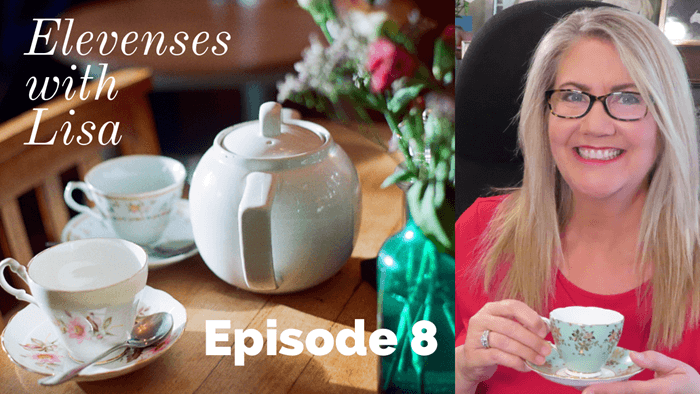
Digital Organization – Episode 8 Show Notes (Elevenses with Lisa)
Live show air date: May 14, 2020
Episode 8 Video and Show Notes
Join me for Elevenses with Lisa, the online video series where we take a break, visit and learn.
In this episode I share viewers’ family history displays, answer your questions about my genealogy organization method, and show you how I file my genealogy digital files. (This series on genealogy organization began with Elevenses with Lisa episode 6.) Scroll down for all the show notes for this episode.
As you’ll remember I launched this show after the first week of the stay at home recommendation in March. Back then my first “PSA” was to resist the temptation to cut your own bangs. Well it turns out that if you have scotch tape, then you’re good to go!
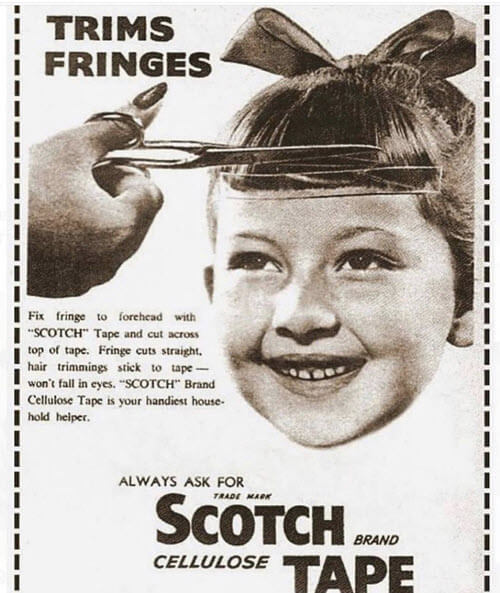
From the Newspapers: Cutting your bangs with scotch tape!
From You:
Betty’s Family Tree Wall
“I feel like we are besties even though we really don’t know each other like our friends and neighbors so much. You are so open about your family and life. Thank you!
Here’s what I have done in my basement with the family pictures that have fallen into my lap over my 67 years. It is a dream come true and being out of the light, the pictures won’t fade as some have done in the past. I had to restore a few on the computer in Paint.
Thank you for showing us how to do things like Google Earth for Genealogy in simplified ways. It’s actually incredible how you do that.”
Thank you for sharing this inspirational photo display with all of us!
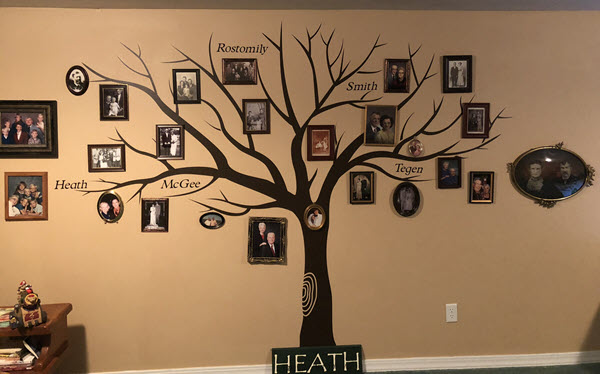
Betty’s family tree photo wall
Maria’s Wall of Photos
From Maria: “I’ve been an avid listener of your podcast, and have thoroughly enjoyed watching Elevenses every Thursday. It’s something I look forward to each week as we’re going through the stay-at-home order here in NYC.
After seeing the great photos on the wall behind you in your videos and the picture you enlarged to hang in your music room, I was inspired to do some family decor of my own.
I’ve been scanning family photos bit by bit as I was passed down albums from my great-grandparent’s and have been going through and labeling them with my grandparents, and decided to get some copies printed so I could enjoy them while keeping the originals safe in archival photo sleeves.”
Here is Maria’s gallery of photos on the wall by her desk providing motivation for continued genealogy research:
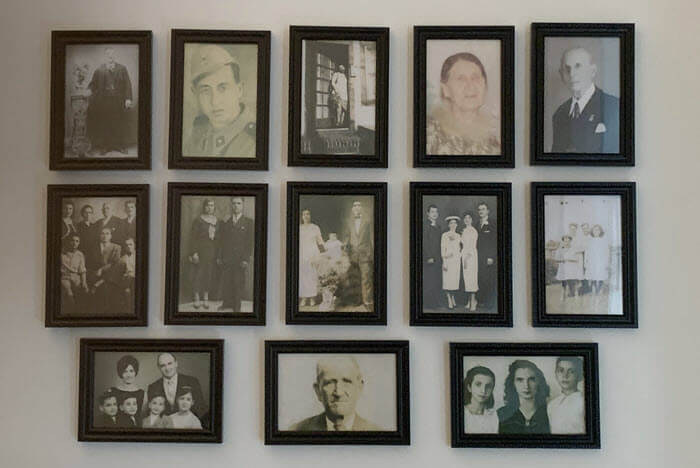
Maria’s family history photo wall
She says “They include ancestors from all sides of my family tree, with the earliest photo here dating to 1915. Thank you again for all that you do.”
Thank you for sharing, Maria!
From Sandra:
Q: Do you still plan on attending the FGS conference, in Kansas City this fall?
A: Yes, as of now it’s still a go. I will be there with bells on unless I hear otherwise.
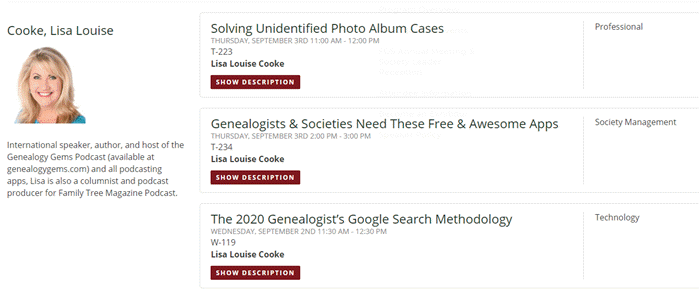
Lisa Louise Cooke’s schedule at FGS 2020 conference. Learn more here.
Answers to Your Genealogy Paper Organization Questions
From Linda:
Q: My question from last week is I wonder why you start with death of each ancestor in your notebooks.
A: Because we do genealogy backwards. Remember, our goal is NOT to have a piece of paper for every event in a person’s life. Our goal is to have a safe place to keep the most precious paper that we want to archive in person’s life. Everything else is digital on our computer and backed up.

Our goal is to go as paperless as possible
From Kelli:
Q: So if you start with a man’s birth, does he not ever show up in his father’s book?
A: As a reminder, the father would be a new tab, not a new notebook. If you decide to start from birth while using my system, birth to marriage would still be under his father.
From Joyce:
Q: What are you really keeping paper copies of?
A: I keep things like original documents, postcards, letters…I even have a doily in one of my books!
Debby commented to Kelli in the chat that she leaves a page in his father’s binder indicating which binder to look in for his complete story. In my system, not every “father” gets a binder, and the notebooks are not the complete story. They are simply the paper archive for the story. The full story is in your master genealogy database software.
If you’re struggling with tossing some of your paper, it can help to ask yourself, do my descendants REALLY want a piece of paper for every single thing I found even if it was just a print-out of a digitized (non-original) document?
The answer is, NO!
In fact, the more paper you store, the more in jeopardy you put your family history research. Future generations may feel burdened by it, and likely won’t have room for it all. If it is an overwhelming amount it is less desirable for your descendants to try to hang on to it. Also, printer ink is expensive.
From Bob:
Q: Do you 3-hole punch items that really don’t need a sheet protector? Like a census or something easily retrieved or printed again?
A: Occasionally, but usually only if it’s a Pending item. Otherwise I don’t print it out in the first place.
From Donna:
Q: If you’re going to archive a digital file, would it be as effective to save it in your master software vs. a separate digital archive on your computer? Is there a benefit to having duplicate files?
A: I don’t attach files to my database. It’s not because it’s not a good idea. But because I started back when you couldn’t do that. And that made me very reliant on having an excellent digital filing system. If I see a marriage in my database which is sourced, I know exactly where to go on my computer to find the source document.
I would not recommend only linking to an online source document. I always download it to my computer. That’s because the document could move, or we could lose access to it depending on the status of our subscription to the website. Read: “If My Ancestry Subscription Expires, What Happens to My Tree?”
From genebuds:
Q: But if I am organizing my archive for donation to a library, should not I have an index? The library won’t have a copy of my software.
A: When donating, ask about their requirements and provided the needed documentation. Options include providing a printed index, a copy of your gedcom file, or other reference material.
From C Davis:
Q: You have to turn on your computer before you use a binder? Your computer boots fast? My RootsMagic does not start in a minute.
A: I leave my computer on all the time. It just goes to sleep. And in fact, turning your computer on and off a couple of time a day can actually shorten it’s life span.
Typically I leave RootsMagic up in the background while I’m doing research. But even if you don’t have it open and you were just looking at your online family tree, you typically know:
1) which surname and therefore which binder
2) which generation based on the age of the person (and therefore which tab to look under.)
Again, notebooks and paper are archival only. Most times I’m turning to my digital files for the backup documents.
I also received great questions about cloud backup. As I mentioned in the show, I use and trust Backblaze. Please use this link to get the best deal at Backblaze. Using this link helps support this free show. If you make a purchase we will be financially compensated for referring you at no additional charge to you.
From Cynthia:
Q: Can you back up multiple computers on Backblaze?
A: You need one account for each computer. However, you can plug an external hard drive into your computer and the subscription for that computer will also cover that hard drive. This is very handy if for example you keep your scanned photos on a separate hard drive so that they don’t use up precious space on your computer.
From Hazel:
Q: I use a laptop and move it around the house and outside the home, and (use the) battery, so will a system like Backblaze work?
A: Yes. All you need is an internet connection. If you are temporarily not connected to the internet, Backblaze just picks back up on backing up when you reconnect.
From C Davis:
Q: Backblaze works with old computers?
A: According to the company, they support back to Windows 7. Click here for the complete list for both Windows and Mac. Please use this link if you would like to get Backblaze for your computer.
Kathy mentioned:
Carbonite now backs up video. I just activated it. It may come automatically now but just check if you start a new subscription.
A: I should clarify that it backed up video back when I used it but ONLY if you manually selected the video to be backed up. I discovered that many of my files were not backed up. According to their website: “**Video files are backed up automatically with the Plus and Prime plans. They can be added to your backup manually on any other plan.”
How to Organize All This Digital Genealogy Stuff!
My system is based on two foundational genealogical record types: the census and pedigree charts (just like my paper system). The folders are organized by head of household, typically the male head of household (just like the census.)
Overarching Folder Logic:
- Families are divided by head of household.
- Children (direct ancestors) are filed under their head of the family (Father) until married.
- After marriage, men (direct ancestors) become a head of household and women are filed under husband (if they are direct ancestors or if there is enough paper to warrant it.)
Creating Folders
Create a new folder on your hard drive called Genealogy.
Within the Genealogy folder, create general topic subfolders such as but not limited to:
- Charts (family tree charts)
- Correspondence
- Countries (general history)
- Database (genealogy software files)
- History (for background material pertinent to your research)
- Research Trips (maps, planning worksheets, and to-do lists)
- Surnames (this folder is very important)
- Heirlooms (can also be included under Surnames if you prefer*)
- Photos (can also be included under Surnames if you prefer*)
- Templates (ex. forms you use routinely)
- Timelines
*I find when working with photos it is easier not to dig into each surname, but rather to have all photos in front of me and then dig in deeper from there. The Surnames folder is heavily focused on documents.
In the Surnames folder create a folder for the surnames you research most. Don’t worry about adding a folder for every surname right now—you can add more as you research. I started with my closest lines, organized as I researched, and then scheduled organizing time to catch up on the rest.
Inside the first surname folder, create folders for the various types of genealogical records such as (but not limited to):
- Births
- Census
- City Directories
- Death
- Journals
- Locations (includes land records, postcards of towns and streets, maps, etc.)
- Letters and Cards
- Marriage
- Military
- Newspapers
- Occupations
- School
- Voter Registrations
- Wills and Estates
Keep a “template” set of these folders. Copy and paste these record folders into surname folders as needed. File your existing record files into the appropriate Surname > (Record Type) folder. Feel free to add an additional layer of folders by heads of households if you want, particularly for families with a lot of digital records. I do this within the records folder.
How to File Genealogy Documents
Record websites typically provide the option to save the record to your computer. Click the Save button and navigate your way to the appropriate folder on your hard drive:
Genealogy > Surnames > Jones > Census. Name the file and click OK.
How to Name Your Computer Files
Name files with the year, head of household, and location.
For example, the 1920 U.S. Federal Census for the Robert M. Moore family file name would be:
1920_Robert_M_Springfield_OH.
This method allows you to quickly spot the census record within the Surnames > Moore > Census folder.
Since you are filing the record by surname and by record type, you don’t need to include those in the file name. By placing the year first, your files will automatically appear in chronological order in the folder.
Photos
I files the Photos folder under the Genealogy folder, not the Surnames folder. The reason for this is that typically when we are working with photos (perhaps for a book project or presentation) we want and need access to all of them. We don’t want to hunt around in our genealogy files for them.
Resources
There are several full length video classes with downloadable handouts in my Genealogy Gems Premium membership that will help you take your organization even further. In fact membership includes over 50 video classes (including 6 on all aspects of using Evernote for genealogy), and an exclusive podcast just for members. Learn more here.
To find files fast I use the free Master Seeker computer app for PC.
Questions for you this week
Here are my questions for you this week. Please leave your comments and questions below.
Did your mom cut your bangs with scotch tape?
Have you created a family history photo wall display in your home?
What are your favorite genealogy organization strategies?
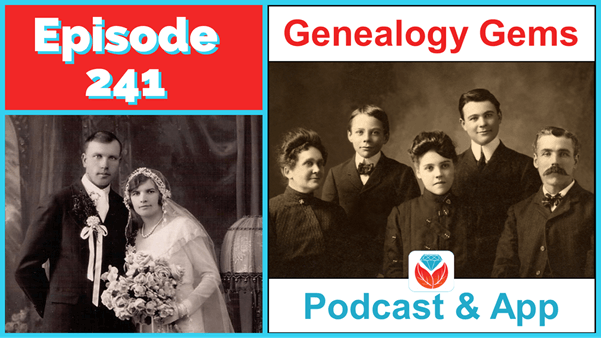
Genealogy Gems Podcast Episode 241
Podcast host: Lisa Louise Cooke
May 2020
In this episode you’ll hear about the change to Google search results, how to reunite found items with their families, and 10 strategies for finding school records for your ancestors.
Watch Elevenses with Lisa live on the Genealogy Gems YouTube channel on Thursdays at 11:00 AM Central. After the live show you can watch the video replay at your convenience. You’ll find the show notes for Elevenses with Lisa here on the Genealogy Gems website.
Google Search Update
Watch Episode 6 which features the latest on Google search results.

New Google Message: “No good results.”
MAILBOX: Reuniting Family History
A while back I received an email from Tim. He writes:
“I’m getting back into genealogy in a meaningful way now that my dissertation is done and I realized that I don’t know what to do with all the ‘stuff’ I’ve taken photos of, picked up at yard sales, etc., that could be of genealogical value to someone but not me. I’ve got yearbooks, pictures of the genealogy information inside family bibles, etc. I used to be able to scan and submit to Mocavo for the world to use but that’s gone. With the Rootsweb mailing lists shutting down, do you have recommendations for where I can submit these things so they benefit others?”
From Lisa:
As a matter of I do have a few recommendations for you!
These days a free blog is your own genealogy bulletin board with much greater reach than Rootsweb had. It’s a great way to get the word out about items that you have that you would like to reunite with their families.
Blogger.com (Google’s free blogging platform) is a good choice.
Video tutorials on how to set up a Blogger blog at my YouTube channel.
Also, listen to Episodes 37-40 of my Family History: Genealogy Made Easy podcast
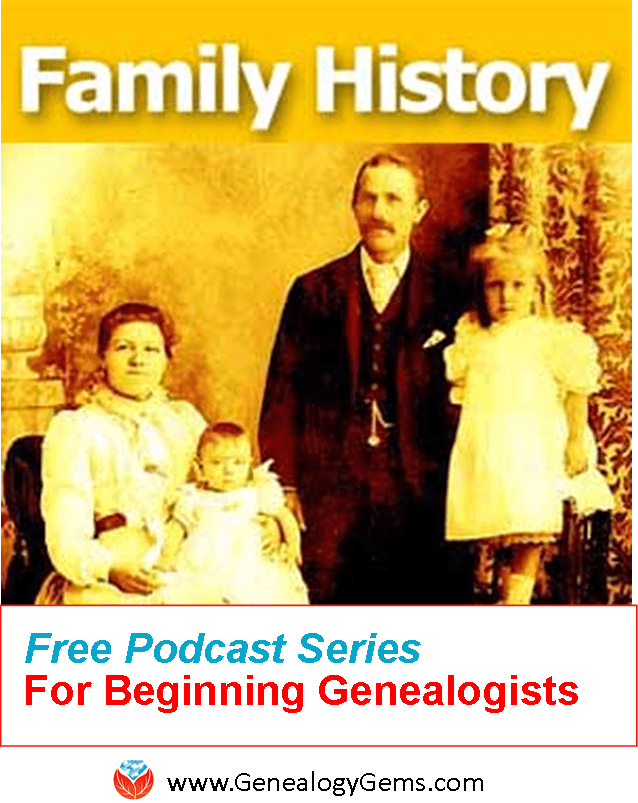
Free podcast by Lisa Louise Cooke
Lisa’s Tips for getting your blog posts:
- One blog post per item
- In addition to a photo, include as much text as you can that describes the item.
- Tag the items with surnames, record types, and locations.
- Encourage people to email you or leave a comment to get in touch.
Interview with Carly Kidd-Osborn
If you have an item that you picked up along your genealogical travels that belongs to someone else’s family history, the Shrubs to Trees – A Pay-It-Forward Genealogy Facebook Group can help. Caryl Kidd-Osborn is the Administrator, and in this episode she explains how the group has helped return over 1500 items to families and how you can enlist their help.
Shrubs to Trees – A Pay-It-Forward Genealogy Facebook Group
From Caryl: “We are almost 2 years old and in that time we have returned over 1500 “lost” memorabilia items to living family. We’ve given back photos, bronze baby shoes, sheet music that was written by someone’s family member, a marriage license and even someone’s cremains. We aren’t a very big group but we have some wonderful folks who just jump right in with researching the items. It’s a private group since we are dealing with living people. It’s very much a collaboration. Our members are genealogists who, like me, just can’t leave an antique store without taking someone else’s family home with them!”
Here are just a few examples of the precious items that the group has managed to return to grateful families:
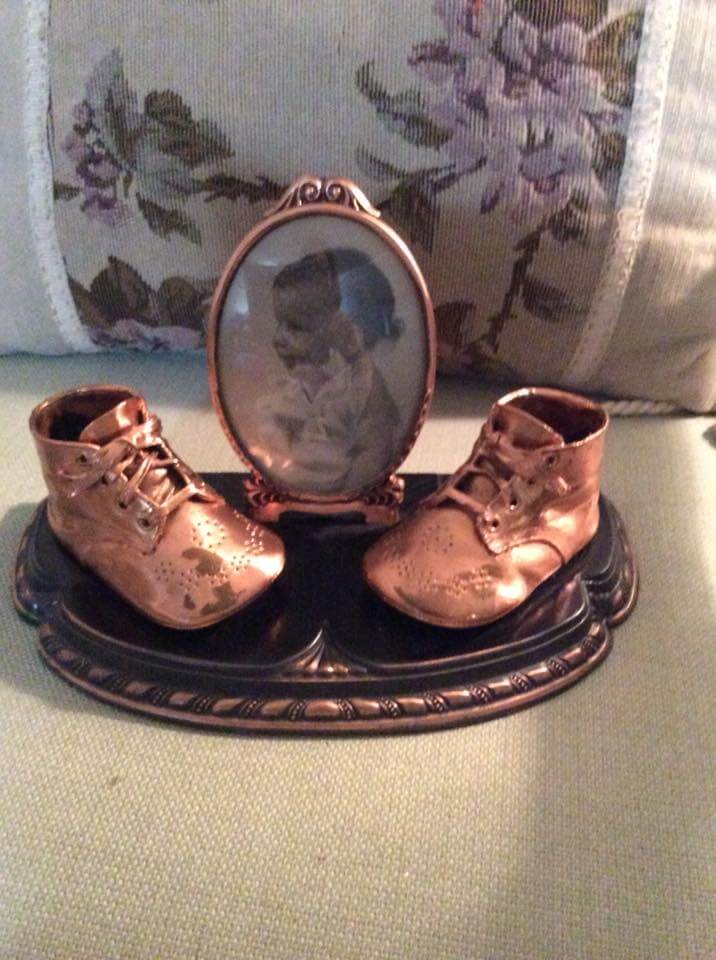
Reunited: Little Renee’s baby shoes
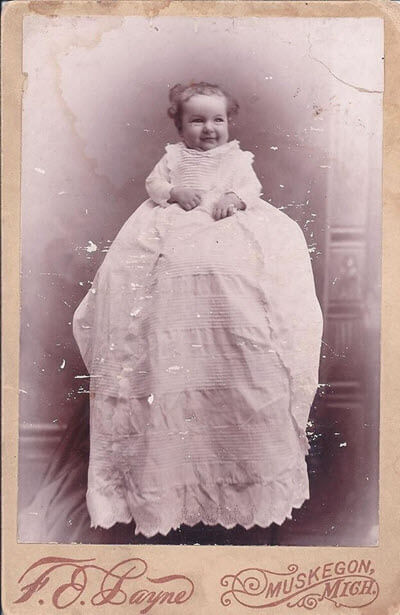
Reunited: A photo of Frances Payne. “Our cutest return,” says Caryl.
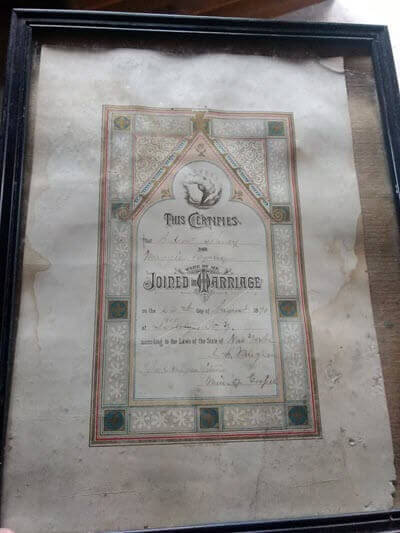
Reunited: Andrew Johney and Maggie Bosley marriage license. This was found at a dump.
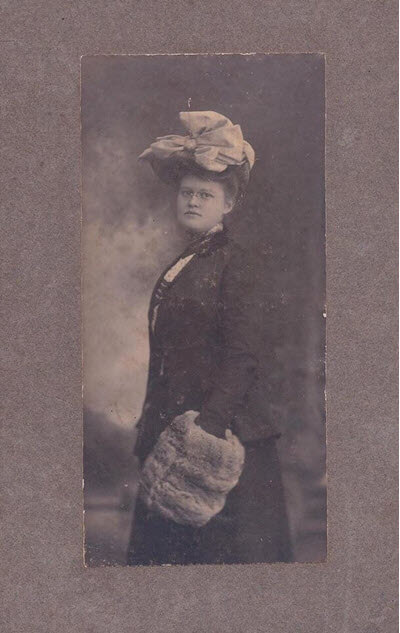
Sarah Fooks Tutherly – photo went to the Historical Society in Laurel, DE. The Fooks family was a prominent family in that town, she was a DAR member.
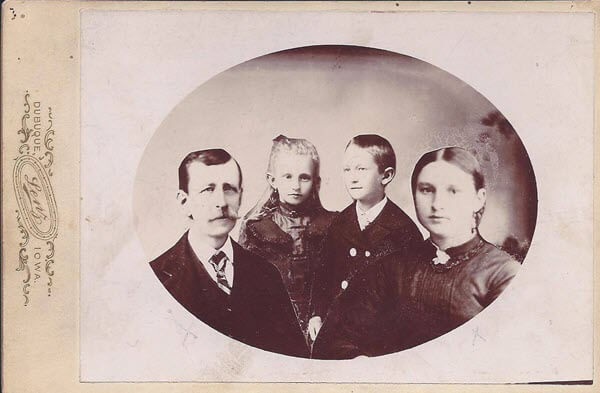
Reunited: The Vandermaas family. The parents had died before the children were of that age so this is a composite of the whole family.
GEM: Top 10 Strategies for Finding School Records for Genealogy
Click here for the complete article on strategies for finding school records.
Download the Show Notes
Become a Genealogy Gems Premium eLearning Member
Gain access to the complete Premium podcast archive of over 150 episodes and more than 50 video webinars, including Lisa Louise Cooke’s newest video The Big Picture in Little Details. Become a member here.
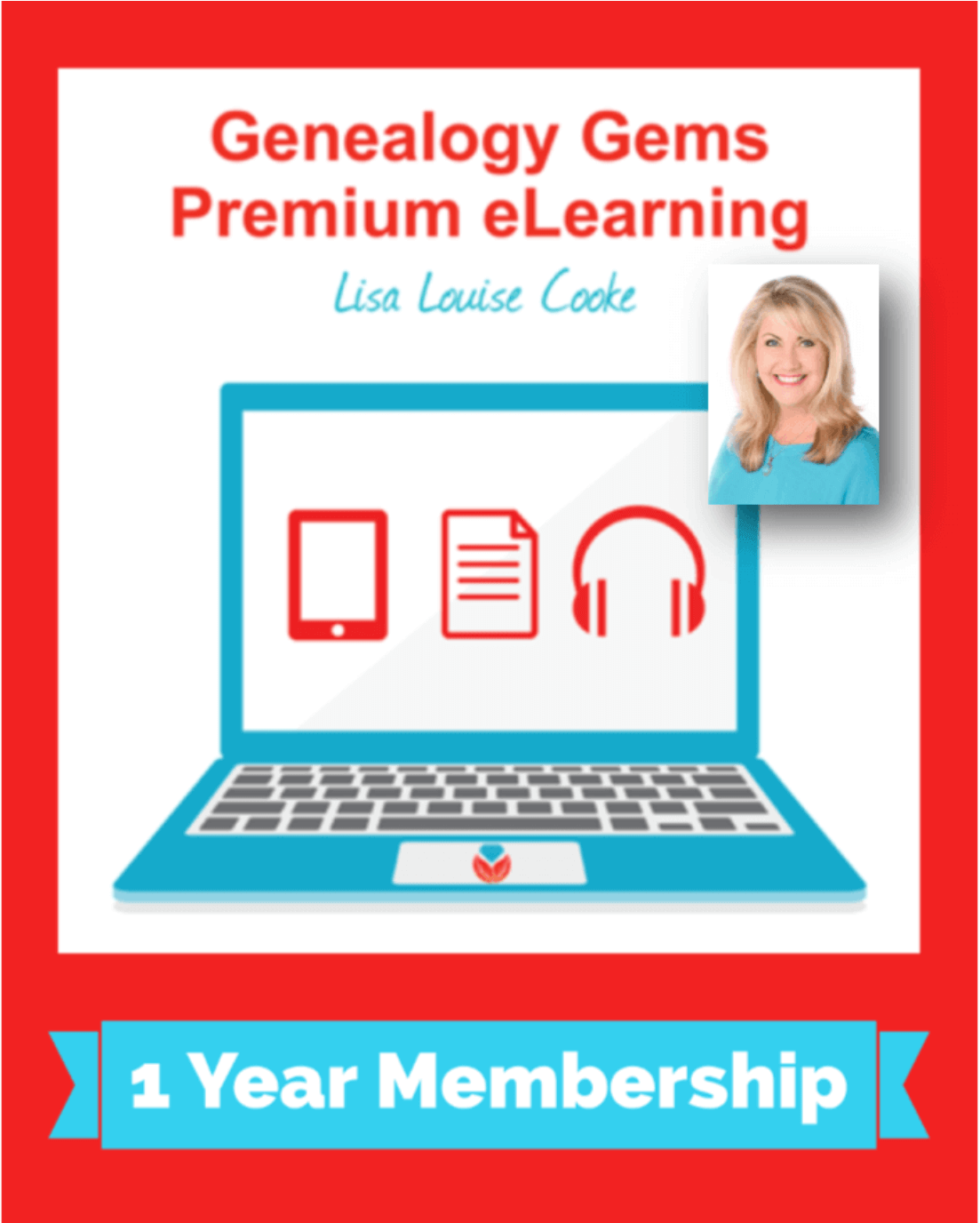
Click to learn more about Genealogy Gems Premium Membership.
Follow Lisa and Genealogy Gems on Social Media:
- Instagram.com/genealogygemspodcast
- Facebook.com/genealogygems
- Pinterest.com/lisalouisecooke
- YouTube.com/GenealogyGems
Stay Up to Date with the Genealogy Gems Newsletter
The Genealogy Gems email newsletter is the best way to stay informed about what’s available with your Premium eLearning Membership. Click here to sign up today.

